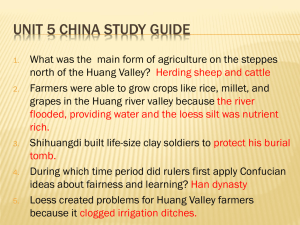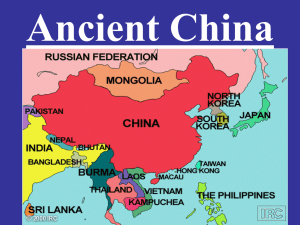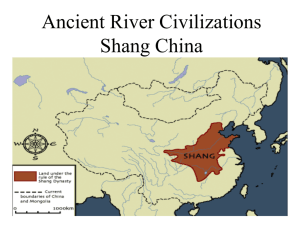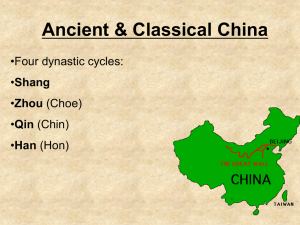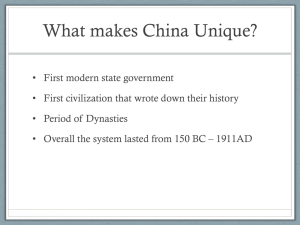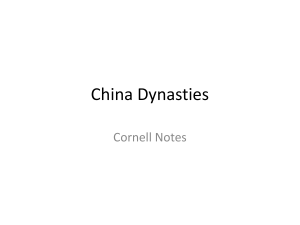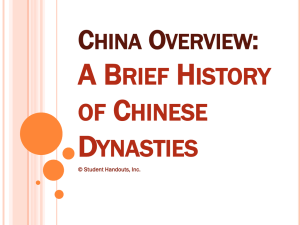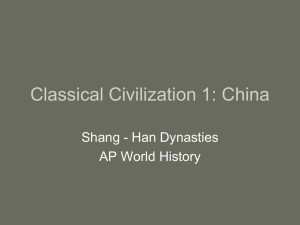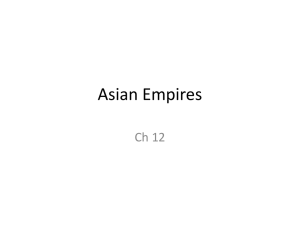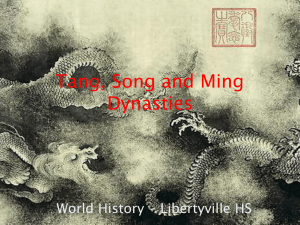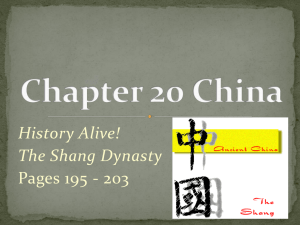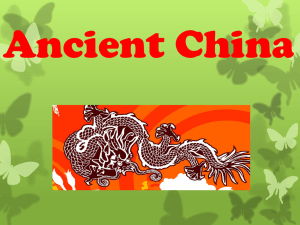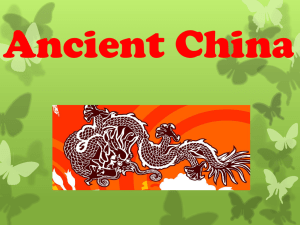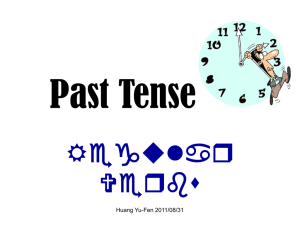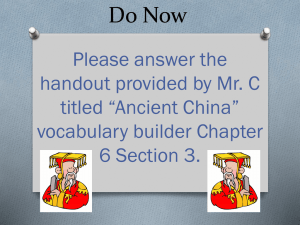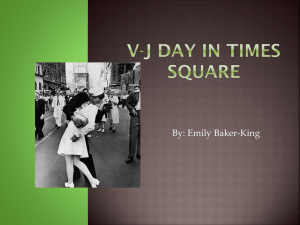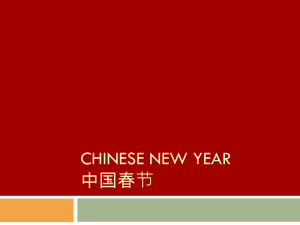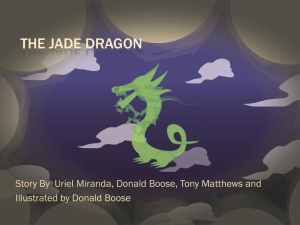Huang He
advertisement
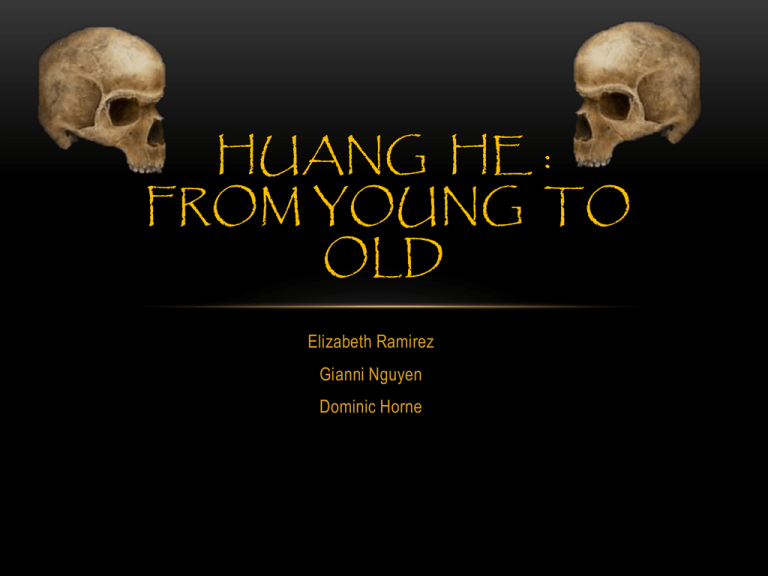
HUANG HE : FROM YOUNG TO OLD Elizabeth Ramirez Gianni Nguyen Dominic Horne TABLE OF CONTENTS • Slide 1: Title Page • Slide 11: Written Language • Slide 2: Table of Contents • Slide 12: The Arts • Slide 3: Introduction • Slide 13: Architecture • Slide 4: Neolithic Revolution • Slide 14: Conclusion • Slide 5: River Valley Civilizations • Slide 15: Bibliography • Slide 6: Huang He Hominids • Slide 16: Bibliography Continued • Slide 7: Geographic Location • Slide 17: Bibliography Continued • Slide 8: Governments Within • Slide 9: New Jobs • Slide 10: The First Dynasties INTRODUCTION Have you ever wondered what it was like to live through the Neolithic Revolution and begin the first civilizations? In this presentation we will show you what it was like to live as a hominid in Huang He and the first dynasties of China. NEOLITHIC REVOLUTION Across the hominids, the Neolithic Revolution was a major change in the early humans way of life. The changes included planting crops in fertile areas instead of moving with their food supply, creating a chief and council, making a barter system and starting to bake, specialize tools, and create artwork. RIVER VALLEY CIVILIZATIONS The Neolithic Revolution was a major turning point in how early hominids lived. Their lives as hunter gatherers turned into more of an agricultural way of life. This greatly increased the amount of food the hominids obtained and allowed for a bigger population. Along with this, civilizations began forming, especially in river valleys. HUANG HE HOMINIDS In 4000 BC, the Huang He civilization began its roots. A hominid group of Homo Erectus, settled in a valley of the Huang He river and began to build their civilization. The hominids chose the area because of the rich farming soil and the easy access to water. The hominids also began to create houses, instead of living in caves, and raise livestock. The hominids that lived in this area are called “Peking Man.” GEOGRAPHIC LOCATION The Huang He is the sixth largest river in the world, measuring 3,395 miles. It starts in the Kunlun mountains of China, and opens its mouth to the Gulf of Bo Hai. Its name, Huang He, or Yellow River, is given because of its color from the silt that it carries down. Because the river washes down silt along its path, this valley was an ideal spot to plant and grow food. However, the river valley also flooded abundantly, and posed some problems. GOVERNMENTS WITHIN The floods that helped provide fertile soils differed in size. Some could have just the right amount of water, while others wiped out the village. To prevent this catastrophe from happening, the people began to build irrigation systems containing canals and dikes. For this to happen, they had to have an agreement with one another to get along. These projects of cooperation resulted in governments occurring to direct the building the canals, and later setting out the rules for which the village would live by. Said to be the founder of the Xia Dynasty, Yu the Great, supposedly tamed the Huang He’s water’s using the irrigation systems. NEW JOBS The expansion of agricultural productivity created more free time for people. In the fields, less people were needed to grow food, which meant that they had the opportunity to become merchants, or artisans. The variation in jobs created different products, creating a more acceptable standard to live by. Ancient Chinese jade carving process THE FIRST DYNASTIES The first dynasty of China is the Xia Dynasty (2070 to 1600 B.C.). The Xia Dynasty is significant, even though some scientist do not believe it ever existed because there are no written records of it, because it helps the Chinese learn about some of their oldest ancestors and the culture that they lived by. The second dynasty in China is the Shang, or Yin, Dynasty (1600 to 1300 B.C.). The Shang Dynasty is the first dynasty with written records. Xia Dynasty Bi Plaque King Tang of the Shang dynasty WRITTEN LANGUAGE The Chinese civilization began to record their history in the Shang Dynasty with oracle bones. Oracle bones are pieces of bone, usually cow skulls or turtle shells that oracles used in their practices. The oracles would carefully engrave questions on the bone to the deities and touched the piece of bone to a hot iron, causing it to crack, letting oracles interpret the answer to the question. These ancient oracle bones help scientists discover China’s past, little by little. THE ARTS Chinese arts occurred before the written language. The earliest art forms were made with jade and pottery. Later, in the Shang Dynasty, bronze was added to create forms of artwork. In the Tang Dynasty era, figure painting was established. ARCHITECTURE As the Chinese civilization grew in population, technology, and knowledge, they created wooden buildings with specific patterns. They also made palaces for their emperors. Their houses were usually made of wood, and they surrounded themselves with earthen walls for protection. Archeologists uncovering Shang dynasty ruins CONCLUSION The hominid civilization of Huang He created the basis for the Chinese culture today. Today, the people of China call the Huang He river the “mother river.” Starting with the hominid group homo erectus, the country of China has grown to have the largest population in the world. BIBLIOGRAPHY WEBSITES: • “Ancient Chines Government.” Ancient China Life.com. 2009. Web. 22 September 2013 < http://ancientchinalife.com/ancient-chinese-government.html>. • “History of China.” History of China. 2007. Web. 19 September 2013 <http://www.history -ofchina.com/>. • “Huang-He River Valley.” Ages of Civilization. Web. 20 September 2013 <http://civilization.yolasite.com/huang-he.php>. • “The Huang He River.” Social Studies for Kids. Web. 19 September 2013 <http://www.socialstudiesforkids.com/articles/geography/huangheriver.htm>. • “The River Valley Civilizations.” The River Valley Civilizations. Web. 19 September 2013 <http://rivervalleycivilizations.com/>. • Wey, Miller. “The Yellow River (Huang He): the Nurturing and Cruel Mother River. China Travel.Net. 20 September 2012. Web. 20 September 2013 <http://blog.chinatravel.net/destinations-attractions/the-yellow-river-history-travel.html>. BIBLIOGRAPHY CONTINUED IMAGES • Brucke-Osteuropa. “The Mother Huang He Statue.” Photograph Syllabus BITES Ancient China. NSW Education and Communities. 21 September 2013. • Caselli, Giovanni. “Homo Erectus.” 23 April 2011. Photograph. Don’s Maps. Don’s Maps. 21 September 2013. • “Governing China? Task Number One: Taming the Yellow River.” Photograph. China Travel.Net. China Travel.Net. 20 September 2013. • Kaizhi, Gu. “Admonitions of the Instructress to the Court Ladies. Photograph. Admonitions of the Instructress to the Court Ladies. China Online Museum. Web. 20 September 2013. • Kim, Terry. “Xia Dynasty Bi Plaque.” 2013. Photograph. The Young Museum of Ancient Cultural Arts. The Young Museum of Ancient Cultural Arts. 21 September 2013. • Lin, Ma. “King Tang of Shang.” 9 May 2013. Photograph. Book from the Sky. WordPress.Com. 21 September 2013. • “A Map of the Huang-he River Valley.” Map. China-Huang-He River Valley (Current Events). EHS World Studies Jackobie. Web. 19 September 2013. BIBLIOGRAPHY CONTINUED • The Neolithic Revolution. January 27 2009. Photograph. Holla @ History (:. WordPress.Com. 21 September 2013. • Qianse. “Wine vessel Lei.” Square Wine Vessel Lei. China Online Museum. Web. 20 September 2013. • “A Rare Glimpse of Ancient Chinese Jade Carving Process 1.” Photograph. Chinese Archaic Jade Shop. Chinese Archaic Jade Shop. 21 September 2013. • “A Rare Glimpse of Ancient Chinese Jade Carving Process 2.” Photograph. Chinese Archaic Jade Shop. Chinese Archaic Jade Shop. 21 September 2013. • “The Roots of Chinese Writing.” Photograph. China Travel.Net. China Travel.Net. 20 September 2013. • “The Ruins of a Shang Dynasty.” Photograph. Cultural China. Cultural China. Web. 20 September 2013. • Skull is First Fossil Proof of Human Migration Theory, Study Says. 12 January 2007. National Geographic Society. National Geographic Society. Photograph. 19 September 2013. • Stories of Yellow River in China. 21 September 2011. Blog Spot. Photograph. 20 September 2013. • Walsh, JE. “Ancient River Valley Civilizations of the Whole World.” 2006. Photograph. Mentorials.com. Mentorials.com. 19 September 2013. • “Wood Racket Support of Beams of Chinese Architecture.” Photograph. Huang-He River Valley. Synathsite. September 2013. 22
